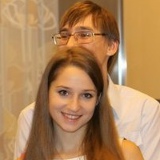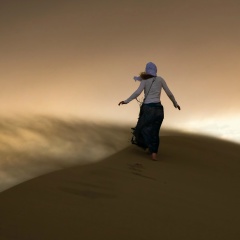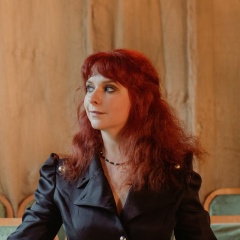Хроники восходящего солнца. Рассвет восьмой.
С утра в бесплатном экскурсионном автобусе, забитом до отказа жадными до халявы европейцам, раздался детский звонкий голос "Hiroshima looks boring..."
6 августа 1945 года в 8 с копейками утра американцы сбросили первую в истории человечества атомную бомбу на город Хиросима. Хиросима на тот момент был преуспевающим промышленно-образовательным центром с населением, подбирающимся к 300000. Бомба разорвалась в 600 м над центром города. В радиусе 2 км от эпицентра взрыва от зданий не осталось ничего. В момент взрыва в эпицентре возникло давление в несколько сот тысяч атмосфер. Сила ударной волны была такой огромной, что в радиусе 500 м от взрыва сила давления составляла 19 тонн на квадратный метр. В момент взрыва в центральной его области температура превысила миллион градусов по Цельсию. Взрывной волной были выбиты стёкла на расстояние до 19 км.
В первые минуты взрыва погибло около 40000 человек, до конца 1945 года погибло всего 140000 человек. Спустя несколько часов после взрыва с неба пошел чёрный радиоактивный дождь. В мемориале хранится кусок стены с черными подтеками. Так как люди страшно хотели пить, то ловили капли ртом или лакали черную воду из канав. Это привело к кровавой рвоте и диареи. Во время взрыва кипела черепица, ее можно потрогать в музее. Надпись гласит: you can touch it. It is safe.
Кроме обугленных тел, сползающей кожи и отваливающихся кусков мяса, бомбардировка обернулась страшными последствиями радиации. Вместо обожженных пальцев отрастали длинные черные ногти с кровеносными сосудами, удаление которых приводило к значительной потери крови. У беременных женщин рождались дети с замедленным развитием. Количество онкологических больных не поддается оценке до сих пор.
В мемориале много личных историй. Например, о брате (7 лет) и сестре (14). Они были сильно обожжены и несколько недель не могли выходить из кровати. Затем наступило улучшение, а потом снова ухудшение. Высокая температура, отхаркивание кровью, диарея. Мальчик умер после того, как во время очередного приступа рвоты выхаркал несколько своих внутренних органов. Девочка выжила. Через 9 лет началась борьба с раком, длившаяся годы: опухоли вырезали, они возвращались, их снова вырезали, они находили другой путь.
Сегодня Хиросима - это бодрый город с множеством велосипедов и туристов. Кроме мемориала важное историческое наследие представляет остов местного ВДНХ, по неизвестным причинам переживший бомбежку. Несколько красивых и довольно трогательных монументов памяти и атмосфера ледяной ненависти к американцам.
Всё в мемориальном комплексе немного чересчур: истории мёртвых детей, сгоревшие коробки из-под бенто ланчей, манекены с обугленными, стекающими к полу пальцами. Но это стоит увидеть. Каждый хоть раз в жизни должен побывать в Хиросиме.
И вот еще факт: 90% выживших так и остались в Хиросиме, не стали никуда уезжать.
#макинагасаки #кабукинедляскуки
С утра в бесплатном экскурсионном автобусе, забитом до отказа жадными до халявы европейцам, раздался детский звонкий голос "Hiroshima looks boring..."
6 августа 1945 года в 8 с копейками утра американцы сбросили первую в истории человечества атомную бомбу на город Хиросима. Хиросима на тот момент был преуспевающим промышленно-образовательным центром с населением, подбирающимся к 300000. Бомба разорвалась в 600 м над центром города. В радиусе 2 км от эпицентра взрыва от зданий не осталось ничего. В момент взрыва в эпицентре возникло давление в несколько сот тысяч атмосфер. Сила ударной волны была такой огромной, что в радиусе 500 м от взрыва сила давления составляла 19 тонн на квадратный метр. В момент взрыва в центральной его области температура превысила миллион градусов по Цельсию. Взрывной волной были выбиты стёкла на расстояние до 19 км.
В первые минуты взрыва погибло около 40000 человек, до конца 1945 года погибло всего 140000 человек. Спустя несколько часов после взрыва с неба пошел чёрный радиоактивный дождь. В мемориале хранится кусок стены с черными подтеками. Так как люди страшно хотели пить, то ловили капли ртом или лакали черную воду из канав. Это привело к кровавой рвоте и диареи. Во время взрыва кипела черепица, ее можно потрогать в музее. Надпись гласит: you can touch it. It is safe.
Кроме обугленных тел, сползающей кожи и отваливающихся кусков мяса, бомбардировка обернулась страшными последствиями радиации. Вместо обожженных пальцев отрастали длинные черные ногти с кровеносными сосудами, удаление которых приводило к значительной потери крови. У беременных женщин рождались дети с замедленным развитием. Количество онкологических больных не поддается оценке до сих пор.
В мемориале много личных историй. Например, о брате (7 лет) и сестре (14). Они были сильно обожжены и несколько недель не могли выходить из кровати. Затем наступило улучшение, а потом снова ухудшение. Высокая температура, отхаркивание кровью, диарея. Мальчик умер после того, как во время очередного приступа рвоты выхаркал несколько своих внутренних органов. Девочка выжила. Через 9 лет началась борьба с раком, длившаяся годы: опухоли вырезали, они возвращались, их снова вырезали, они находили другой путь.
Сегодня Хиросима - это бодрый город с множеством велосипедов и туристов. Кроме мемориала важное историческое наследие представляет остов местного ВДНХ, по неизвестным причинам переживший бомбежку. Несколько красивых и довольно трогательных монументов памяти и атмосфера ледяной ненависти к американцам.
Всё в мемориальном комплексе немного чересчур: истории мёртвых детей, сгоревшие коробки из-под бенто ланчей, манекены с обугленными, стекающими к полу пальцами. Но это стоит увидеть. Каждый хоть раз в жизни должен побывать в Хиросиме.
И вот еще факт: 90% выживших так и остались в Хиросиме, не стали никуда уезжать.
#макинагасаки #кабукинедляскуки
Chronicles of the rising sun. Dawn of the eighth.
In the morning, in the free tour bus, full of greedy freebies to Europeans, there was a children's ringing voice "Hiroshima looks boring ..."
On August 6, 1945, at 8 in the morning, the Americans dropped the first atomic bomb in the history of mankind on the city of Hiroshima. Hiroshima at that time was a successful industrial and educational center with a population approaching 300,000. The bomb exploded 600 meters above the center of the city. Within a radius of 2 km from the epicenter of the explosion, nothing was left of the buildings. At the time of the explosion, a pressure of several hundred thousand atmospheres appeared in the epicenter. The force of the shock wave was so huge that, within a radius of 500 meters from the explosion, the pressure force was 19 tons per square meter. At the time of the explosion in its central region, the temperature exceeded one million degrees Celsius. The blast wave smashed the glass to a distance of 19 km.
In the first minutes of the explosion, about 40,000 people died, and by the end of 1945, only 140,000 people died. A few hours after the explosion, black radioactive rain began to fall from the sky. The memorial stores a piece of wall with black stains. Since people were terribly thirsty, they would catch drops in their mouths or lacquer black water from ditches. This led to bloody vomiting and diarrhea. During the explosion, the tiles boiled, you can touch it in the museum. The inscription says: you can touch it. It is safe.
In addition to charred bodies, sliding skin and falling off pieces of meat, the bombardment turned into terrible consequences of radiation. Instead of burnt fingers, long black nails with blood vessels grew, the removal of which resulted in significant blood loss. Pregnant women were born children with slow development. The number of cancer patients is not measurable so far.
There are many personal stories in the memorial. For example, about a brother (7 years old) and a sister (14). They were severely burned and could not get out of bed for several weeks. Then came the improvement, and then the deterioration again. High fever, expectoration, diarrhea. The boy died after vomiting of some of his internal organs during the next attack. The girl survived. After 9 years, the fight against cancer began, which lasted for years: the tumors were cut out, they came back, they were cut out again, they found another way.
Today, Hiroshima is a bouncy city with many bicycles and tourists. In addition to the memorial, an important historical heritage is the skeleton of the local ENEA, for unknown reasons, survived the bombing. Several beautiful and quite touching monuments of memory and the atmosphere of icy hatred of Americans.
Everything in the memorial complex is a bit too excessive: the stories of dead children, burnt bento lunch boxes, mannequins with charred, flowing down to the floor fingers. But it is worth seeing. Everyone at least once in his life should go to Hiroshima.
And here's another fact: 90% of the survivors remained in Hiroshima, did not begin to leave anywhere.
# Makinagasaki # Kabukinledlyaskuki
In the morning, in the free tour bus, full of greedy freebies to Europeans, there was a children's ringing voice "Hiroshima looks boring ..."
On August 6, 1945, at 8 in the morning, the Americans dropped the first atomic bomb in the history of mankind on the city of Hiroshima. Hiroshima at that time was a successful industrial and educational center with a population approaching 300,000. The bomb exploded 600 meters above the center of the city. Within a radius of 2 km from the epicenter of the explosion, nothing was left of the buildings. At the time of the explosion, a pressure of several hundred thousand atmospheres appeared in the epicenter. The force of the shock wave was so huge that, within a radius of 500 meters from the explosion, the pressure force was 19 tons per square meter. At the time of the explosion in its central region, the temperature exceeded one million degrees Celsius. The blast wave smashed the glass to a distance of 19 km.
In the first minutes of the explosion, about 40,000 people died, and by the end of 1945, only 140,000 people died. A few hours after the explosion, black radioactive rain began to fall from the sky. The memorial stores a piece of wall with black stains. Since people were terribly thirsty, they would catch drops in their mouths or lacquer black water from ditches. This led to bloody vomiting and diarrhea. During the explosion, the tiles boiled, you can touch it in the museum. The inscription says: you can touch it. It is safe.
In addition to charred bodies, sliding skin and falling off pieces of meat, the bombardment turned into terrible consequences of radiation. Instead of burnt fingers, long black nails with blood vessels grew, the removal of which resulted in significant blood loss. Pregnant women were born children with slow development. The number of cancer patients is not measurable so far.
There are many personal stories in the memorial. For example, about a brother (7 years old) and a sister (14). They were severely burned and could not get out of bed for several weeks. Then came the improvement, and then the deterioration again. High fever, expectoration, diarrhea. The boy died after vomiting of some of his internal organs during the next attack. The girl survived. After 9 years, the fight against cancer began, which lasted for years: the tumors were cut out, they came back, they were cut out again, they found another way.
Today, Hiroshima is a bouncy city with many bicycles and tourists. In addition to the memorial, an important historical heritage is the skeleton of the local ENEA, for unknown reasons, survived the bombing. Several beautiful and quite touching monuments of memory and the atmosphere of icy hatred of Americans.
Everything in the memorial complex is a bit too excessive: the stories of dead children, burnt bento lunch boxes, mannequins with charred, flowing down to the floor fingers. But it is worth seeing. Everyone at least once in his life should go to Hiroshima.
And here's another fact: 90% of the survivors remained in Hiroshima, did not begin to leave anywhere.
# Makinagasaki # Kabukinledlyaskuki
У записи 23 лайков,
0 репостов.
0 репостов.
Эту запись оставил(а) на своей стене Анастасия Вашкелите











































